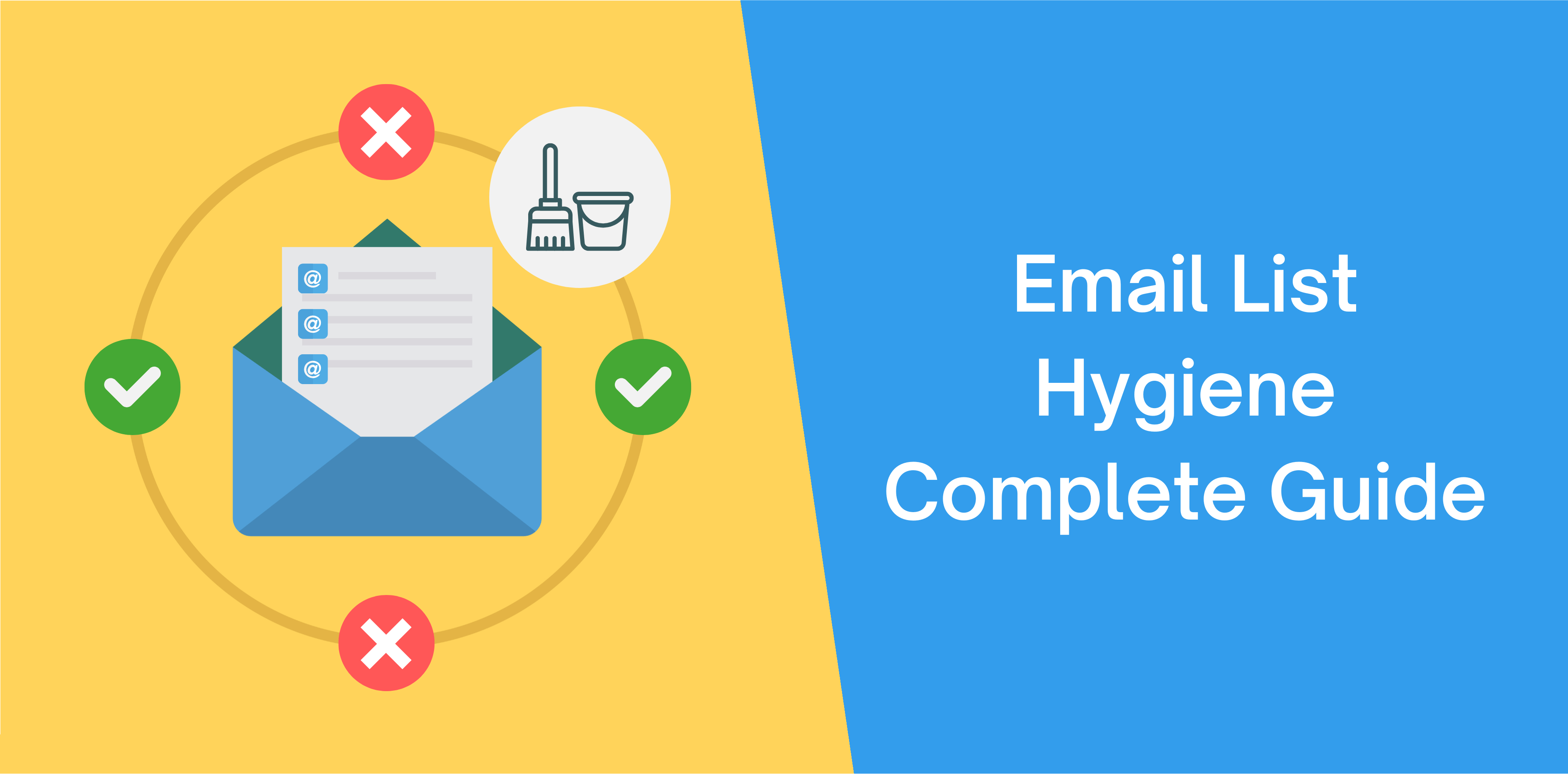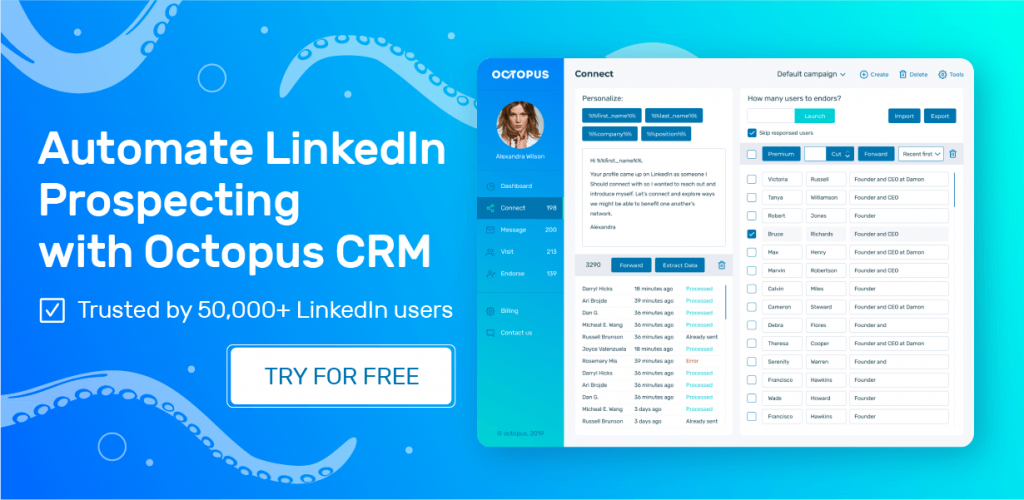All email marketers want the same thing: higher customer engagement rates!
But when it comes to improving email engagement, there are many factors you need to consider. It includes email deliverability, email scrubbing, and email list hygiene.
A clean and healthy email list can go a long way in affecting customer engagement and spam rates. Below we discuss list hygiene, its importance, and best practices. Let’s dive in!
Read also: Best Email Drip Campaign Examples
What Is Email Hygiene?
Email hygiene involves reviewing and cleansing your email list. It comprises verifying invalid or unengaged emails from your subscribers’ list.
Over 20% of email signups include syntax errors, typos, faulty domains, and other errors. Thus, email cleansing is essential to ensure you send emails to engaged subscribers.
Check other email marketing statistics you should deal with.
In addition, maintaining good email hygiene helps businesses:
- Improve reputation
- Increase email engagement rates
- Mitigate the risk of landing in the spam folder
Why Is Email Hygiene Important?

Now that you know what email hygiene is, let’s discuss why it’s crucial:
It Allows You to Limit Unsubscribers
A high number of subscribers isn’t always good news. Sometimes, it’s a sign you need to review engagement.
Verifying email addresses allows you to weed out subscribers who have lost interest.
It Improves Your Email Deliverability
Here’s the thing: a disengaged subscriber list can hurt your reputation. They can also impact your email deliverability.
On the contrary, practicing email hygiene ensures you don’t send users irrelevant content. That way, you can enhance your reputation and email deliverability.
It Helps Reduce Spam Complaints
Picture this: you spend hours crafting a killer email, selecting the ideal font and images. You hit send, only to deliver it to a disengaged list.
Your audience is uninterested in your emails and can’t find the unsubscribe button. What do they do? They report your email as spam!
The result? ISPs will flag your email account for sending unwanted solicitations. And now all your emails now reach the spam folder.
But by reviewing your mailing list, you can remove disengaged subscribers. That way, you’ll receive fewer spam complaints.
It Boosts Your Open Rate
When you notice a drop in your open rate, it’s time to verify and remove inactive and invalid subscribers. However, we recommend running a re-engagement campaign to revive old subscribers.
But if your email campaign fails, you must remove inactive users.
When Should You Clean Your Email List?
Every small and large business needs to make email hygiene a regular practice. But do you know when you should deep cleanse your email list?
Here are five reasons you need to focus on improving email health:
You Plan to Transfer Data Between CRMs
Poor CRM data can reduce sales productivity while negatively impacting ROI. Research reveals that businesses lose millions of dollars due to data quality.
You Receive a Large Number of New Subscribers
Consider verifying their legitimacy if you suddenly gather new email addresses. That way, you can combat issues that hurt your sender’s reputation.
You Want to Switch ESPs
Getting new ESPs offers the perfect opportunity to clean your email list. Before you switch, retain only active subscribers.
You’re Preparing to Launch a Re-engagement Campaign
Review yours before launching your re-engagement campaign. That way, you can eliminate spam traps and invalid email addresses from your list.
How Often Should You Clean Your Email List?
Organizations should clean their email lists at least once annually. However, we recommend reviewing your open rate, unsubscribes, and spam rates every quarter.
You may use real-time verification web forms to avoid invalid, typos, and fraudulent addresses.
Email Hygiene Best Practices
By now, you’ve learned the when and why of email hygiene. So, what’s left?
The how-to!
Here’s a comprehensive list of best practices for maintaining good email hygiene:
1. Wave Goodbye to Inactive Subscribers
Deep cleansing is the most crucial step of email list hygiene. Instead of allowing inactive email subscribers to hog your email list, weed them out.
But don’t delete your disengaged subscribers right away! Launch a re-engagement email campaign. This way, you can revive emails and verify whether they still find your email interesting.
However, we recommend avoiding repeating this step often. Often, your subscribers are too busy to open your email; removing them can lead to disinterest.
For this reason, it’s crucial to evaluate the cause of reduced email engagement:
- You’re Missing the Mark – Irrelevant emails will undoubtedly end in the bin. So, ensure your emails are relevant and catchy.
- You Didn’t Offer Any Value – There’s nothing wrong with promotional emails until it lacks value.
- Your Email Doesn’t Stand Out – The fact is that everyone receives hundreds of emails daily. If you want the subscriber to read your email, give them a reason to click.
2. Create Attention-Grabbing Subject Lines
Research by Experian shows that users are 29% more likely to open an email with their name. In addition, personalized email open lines enjoyed a whopping six times higher transaction rate.
While writing emails, create catchy subject lines that ignite curiosity within the subscriber. Consider testing multiple subject lines to identify which ones attract clicks. In addition, you should create good email sign-offs with a proper signature, so that the recipient sees your interest and wants to respond to you.
3. Segment Your Email List

Use your inactive subscriber list to learn more about your consumer base. Segment your email list based on shared interests, last purchase date, etc.
Then, you can schedule a re-engagement campaign. But before that, gauge performance and gather relevant information about each segment. As a result, you can re-engage users and reduce the risk of unsubscribing.
4. Use a Professional Email Address
Here’s the truth: a professional email address can make a lasting first impression.
Emails are among the most common forms of communication. Thus, it’s no surprise that every brand has a professional email address. Not only does it help foster credibility, it also ensures DMARC policy compliance.
The DMARC stands for Domain-based Message, Authentication, Reporting, and Conformance authentication protocol. It ensures email senders don’t use company names to deceive subscribers.
5. Include an ‘Opt Down’ Button
Many disengaged subscribers are people too busy to open your emails. So, replace your ‘opt-out’ button with an ‘opt-down’ one to allow users to receive fewer emails.
That way, subscribers can stay engaged at a rate that suits their needs. The result? Happy subscribers and successful email marketers with well-segmented email lists!
6. Sprinkle Personalization in Your Emails
Did you know email personalization can improve open rates by 26%?
The first step to creating an engaged subscriber list is making the recipient feel seen. You can achieve this by personalizing the email and retargeting a specific audience. Only when they see the value in your copy will they open your messages and respond.
For this reason, email marketers need to go beyond creating catchy subject lines. Your message should comprise relevant information with personalization elements. It also assures the reader you’re not a spammer.
7. Take Advantage of Automation
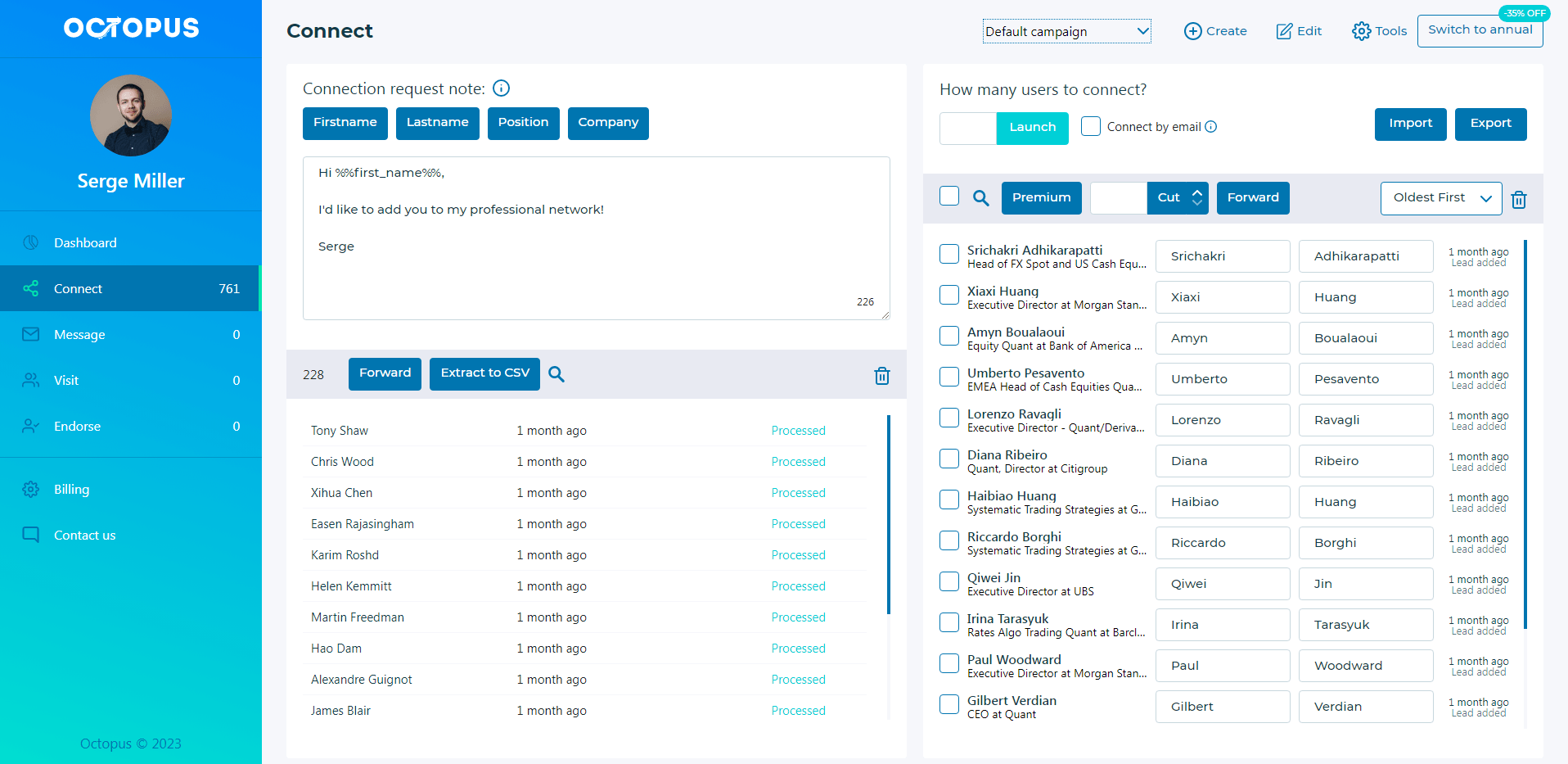
Leveraging automation can ease the email-sending process. A robust CRM for sales can help eliminate repetitive tasks.
Wondering how? The CRM triggers specific actions to subscribers based on predefined actions.
For instance, you can automate a re-engagement campaign. That way, when subscribers go silent, the tool will automatically send an email.
Related article: Best Email Marketing Automation Tools
8. Check Unanswered Emails
An excellent way of avoiding invalid emails is with the double opt-in method. Not only does it ensure the subscriber wants to join your newsletter, but it also reduces errors.
Double opt-in signup involves entering your email address during registration. It’s followed by confirmation through an email containing a link.
Although the process involves an extra step, it’s worth the effort. That way, you can reduce the risks of unwanted emails.
9. Learn the Secrets to Re-engaging Contacts
As we discussed, deleting inactive contacts is never a good idea. Instead, launch a re-engagement campaign explaining you would love to hear back. Alternatively, you can send a witty email asking if they want to remain in your newsletter.
In addition, your re-engagement emails should provide users value. It should remind them why they subscribed in the first place. Remember to create segments before you send re-engagement emails.
10. Steer Clear off Buying Lists
Buying an email list can impact your email hygiene and spam complaints. Why? Because the email users receiving your mails are not your target audience!
In addition, email lists may include spam traps, reducing your email deliverability rate. Therefore, it’s best to avoid buying email lists, no matter how tempting it appears.
11. Focus on Improving Bounce Rate
Bounced emails occur due to typos, syntax errors, and other issues. Reviewing your email list for bounced emails can improve your deliverability.
Generally, email bounces are of two primary types:
- Soft Bounces – This refers to a temporary deliverability issue, such as a down server or full inbox. Often, resending the email acts as a viable solution.
- Hard Bounces – This occurs due to a permanent deliverability problem, like an invalid email. You must weed out these emails from your list.
Remember ESPs track your hard bounce rate. They will use it to determine your credibility and reputation. Thus, getting too many bounces can cause you to land in the spam folder.
12. Regularly Audit Your Email List
You can maintain the health of your email list by removing invalid, inaccurate, and redundant addresses. For this reason, you should add safeguards. These will verify every address before adding it to your newsletter.
However, since no web form offers 100% accuracy, performing routine check-ups is vital. That way, you can maintain a healthy email list!
13. Learn More about Your Email Audience
While cleansing your email list, determine whether your audience aligns with your ICP. In addition, separate your subscribers into lists based on interests and demographics.
For instance, you could send a special discount for loyal subscribers and newcomers. Or a ‘we miss you’ coupon for disengaged subscribers. Creating multiple lists instead of forcing everyone into one can improve conversion rates.
14. Seek Expert Advice
Lastly, if you’re new to email marketing, we recommend seeking expert help. There are tons of free resources available, including consultancy and courses. Using these, you can receive real-time guidance.
It allows you to save costs and resources while ensuring success and improved ROI!
5 Best Email List Cleaning Services
Not sure you can handle email list hygiene yourself? No worries! Here are the top five email list cleaning services to help you get started:
Email List Verify
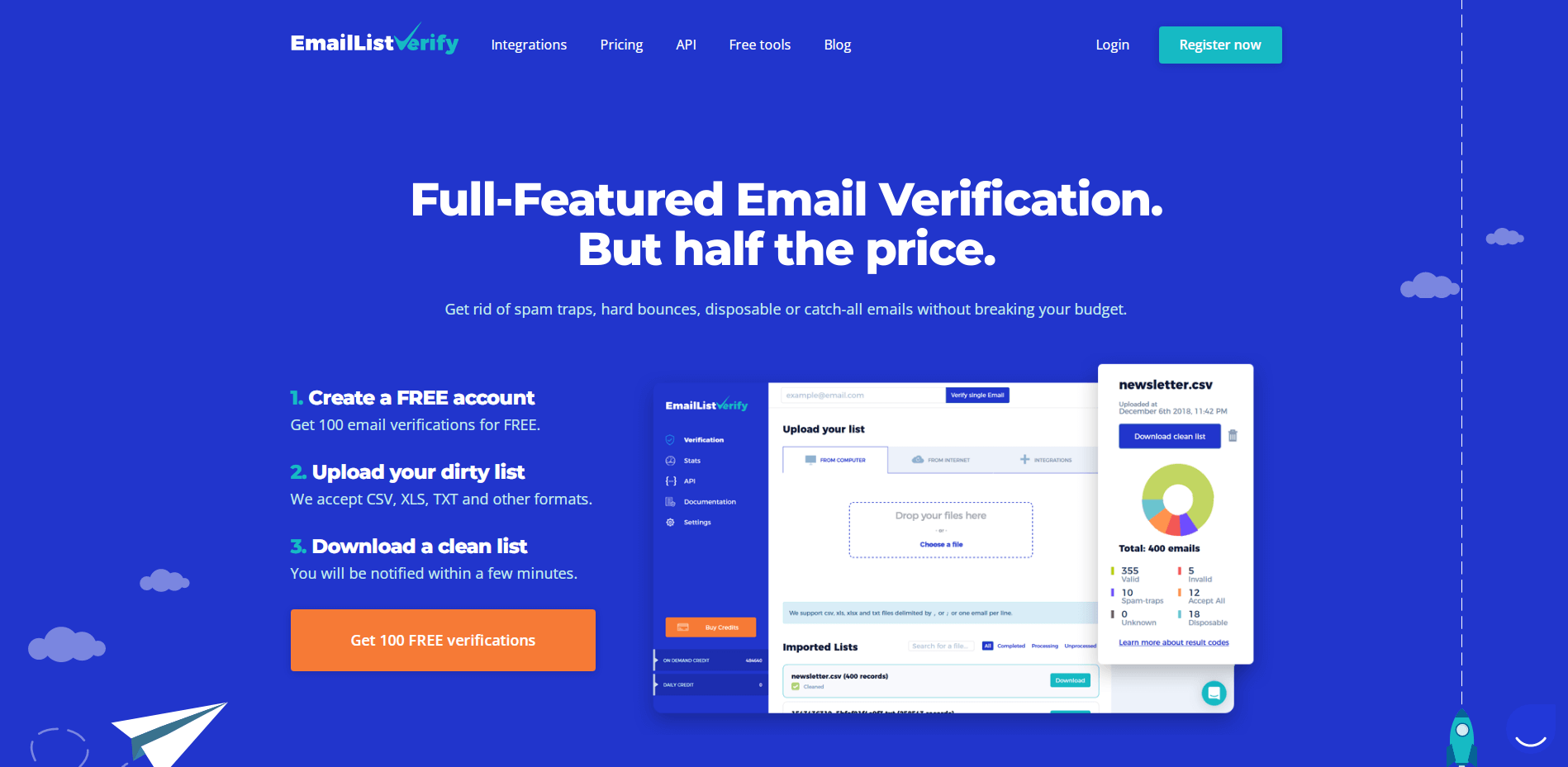
Email List Verify is a top-notch cleaning tool. The service is famous for its user-friendliness and standout features. The software boasts 99% accuracy, meaning it’s ideal for weeding out low-quality subscribers.
With EmailListVerify, users can identify invalid and inactive accounts and spam traps. You can also detect disposable accounts and threats. What’s more? The tool offers you an easy-to-use and interactive dashboard.
Furthermore, Email List Verify offers dynamic features for checking and maintaining email health. The best part is you don’t need any expertise to use the tool!
Pros
- It offers a 99% deliverability rate
- Access to around-the-clock live chat and email support
- Provides bulk email verification
- API integration for real-time email verification
- Affordable services
Cons
- It lacks blocklist monitoring
ZeroBounce
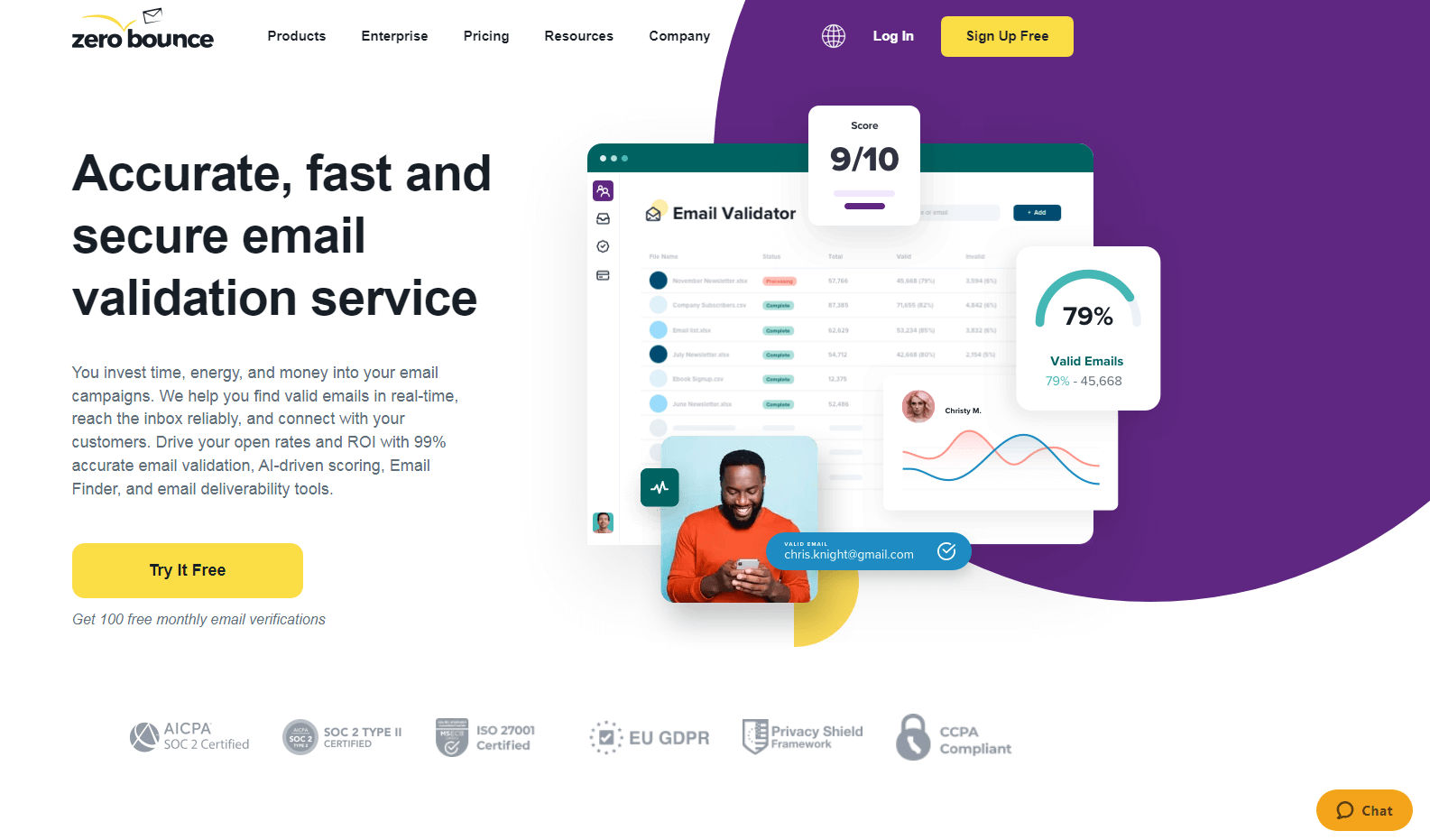
ZeroBounce is another robust tool helping you hit your email deliverability goals!
The tool’s email checkers analyze your list to eliminate misleading email addresses. The best part? The software is 98% accurate!
Moreover, ZeroBounce’s API allows users to check new email addresses in real time. The tool also suggests correcting email typos. That way, you can reduce mistakes.
Pros
- Allows you to discover the name, location, and gender of consumers
- 24/7 customer support via chat, email, and phone
- Integrates with email marketing automation platforms
Cons
- Comparatively expensive, starting at 2000 emails
MailGet
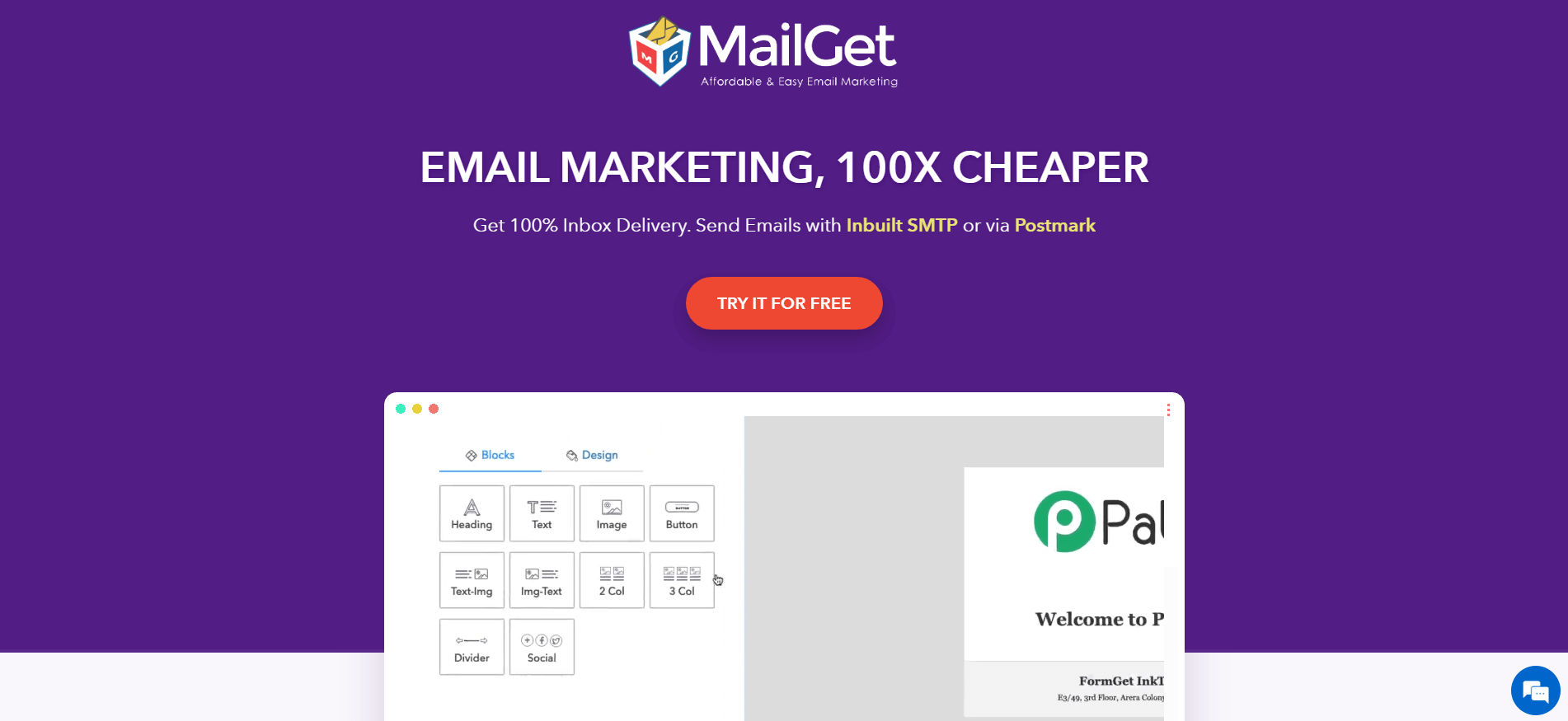
If your goal is to boost your email deliverability rate and reduce bounce rates, MailGet is the way to go!
The tool’s excellent user interface makes cleaning email lists a breeze. In addition, the service’s easy-to-use features ease the detection of junk emails. That way, you can remove typos, disposable accounts, and syntax errors.
Besides, Mail Get integrates with SendGrill and Amazon SES for a seamless process. As a result, you can boost inbox placement by 99%.
Pros
- Improve email deliverability
- Easy-to-use drag-and-drop editor
- Segments subscriber lists
- Integrate with multiple service providers
- Around-the-clock customer support
Cons
- Expensive
Bounceless
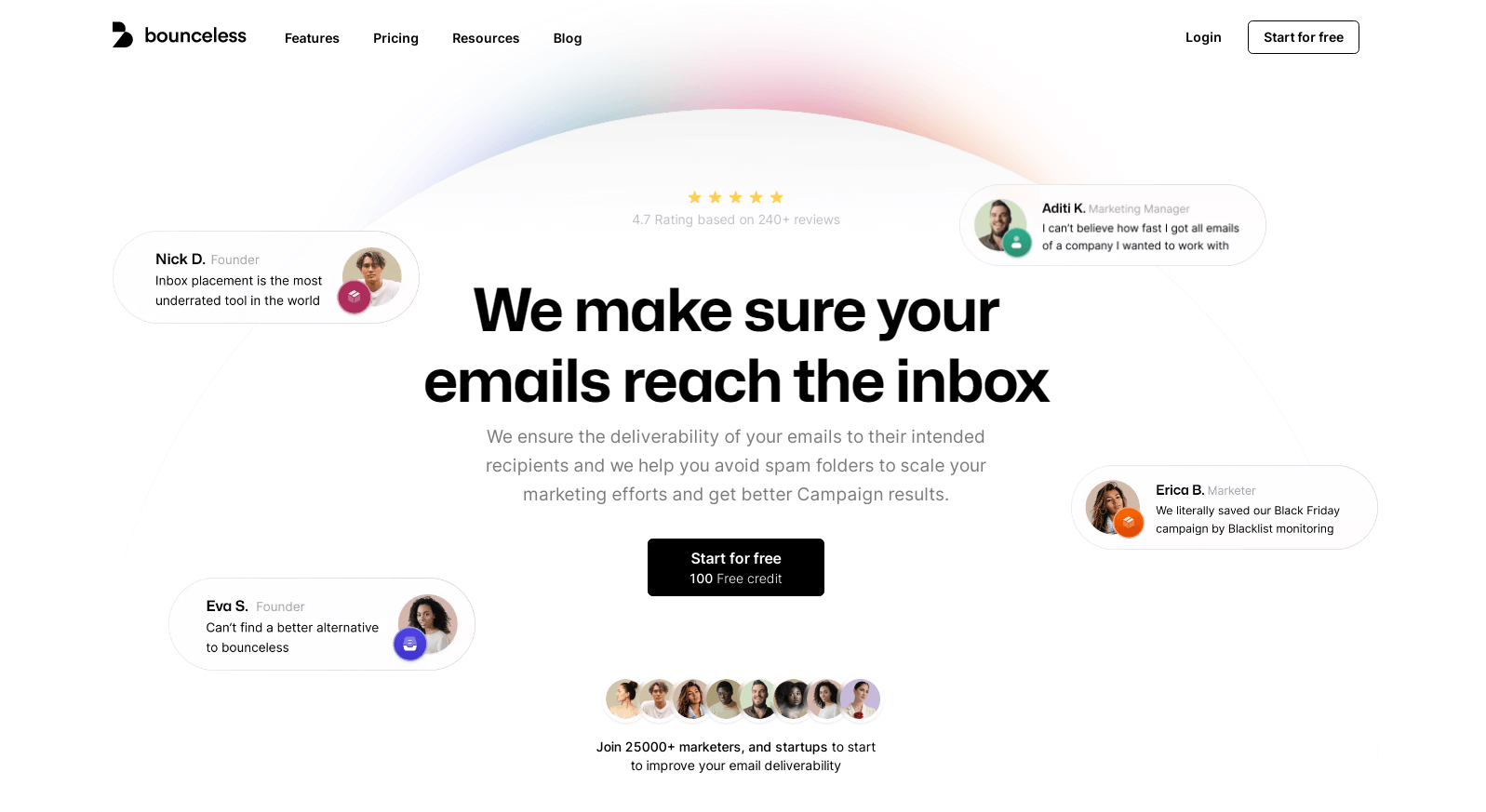
Bounceless is an efficient email list cleaning tool that lets you hunt wrong emails. The software offers a 99% accuracy rate by producing robust reports.
In each report, Bounceless highlights emails in six primary categories. It includes accept all, spam traps, deliverable, invalid, and unknown.
That way, you can eliminate poor emails and enhance your deliverability rate.
Pros
- Easy-to-use and interactive interface
- Easy-to-navigate features
- Access to 24/7 online chat and phone support
- Offers a robust knowledge base
- Pocket-friendly services
Cons
- It lacks a blocklist checking
- There are no predictive deliverability reports
Email Marker
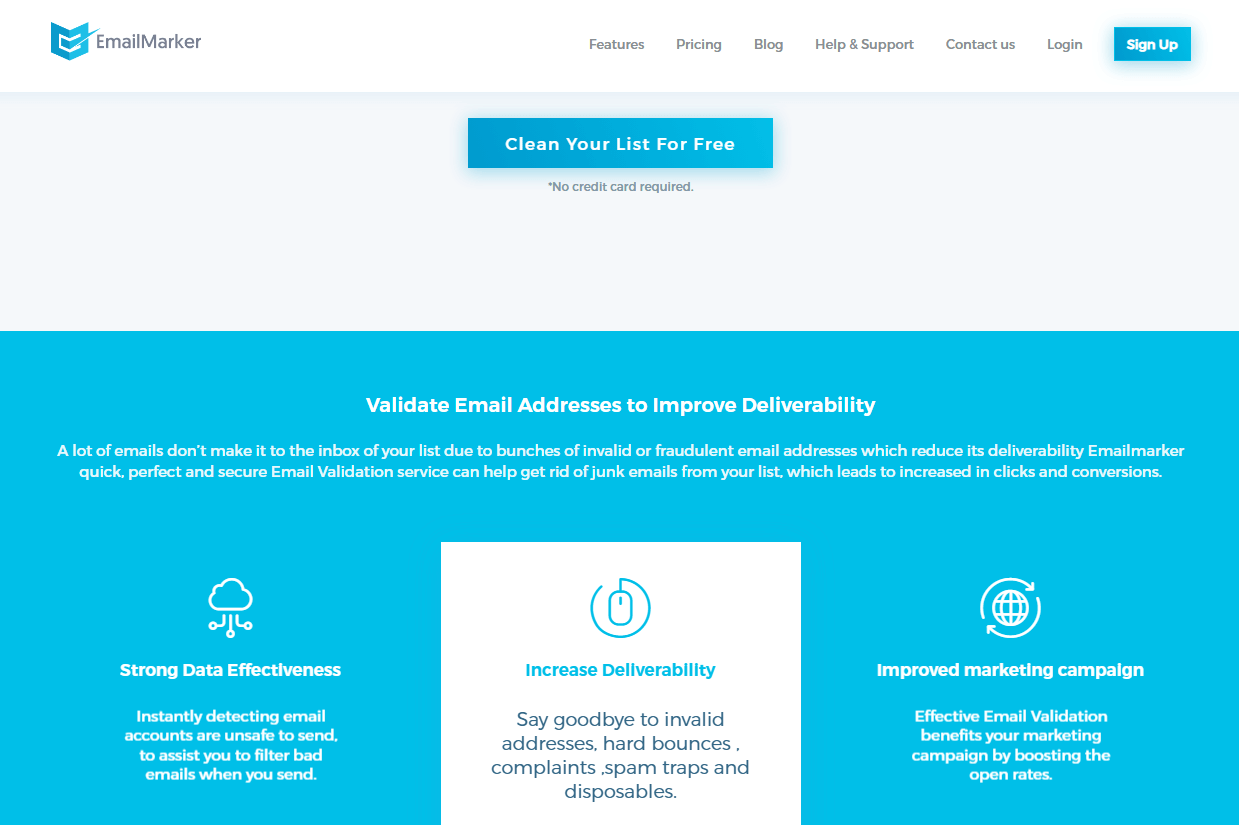
EmailMarker is another email list cleaning tool ideal for reducing your bounce rate. The tool lets you upload email lists on their web and mobile application.
What’s more? The easy-to-use tool offers a refund if you get a 5% bounce rate. Additionally, it provides users with real-time integrations and API.
Moreover, it eliminates syntax errors, duplicates, and invalid emails. You can also enjoy a 97% verification accuracy!
Pros
- Verifies bulk emails
- Cost-effective
- 24/7 customer support
- Protects your data
Cons
- Comparatively less accurate
- Weak integration
Reviving Emails – How to Re-engage a Cold Email List
Noticing bulk inactive email subscribers? Then it’s time to craft a compelling offer that excites your subscribers to reconnect!
Here are several ideas to re-engage disengaged email subscribers:
- Create a Giveaway: Attract your target audience by offering enticing products, discounts, or coupon codes.
- Come Up with a Re-engagement Campaign: Get your audience excited about your brand by creating a multi-step re-engagement campaign. It’ll also allow you to identify who stays inactive.
- Host a Live Event or Webinar:Consider holding an Instagram, Facebook, or LinkedIn Live. Here you can discuss a topic that matters to your subscribers.
- Send Your Subscribers a Call or Letter: Show your email newsletter you care by sending them a postcard or calling to ask how they are doing
Conclusion
Email marketing is crucial to every industry. Thus, keeping a clean and hygienic email list is critical for your email campaign’s success.
Not only can you improve your ROI with better email list hygiene, but you can also increase sales! In addition, by maintaining good email hygiene, you can improve deliverability.
Make email list cleaning a priority to manage open, click-through, spam, and bounce rates. You can ease the process using one of the five tools we discussed!
